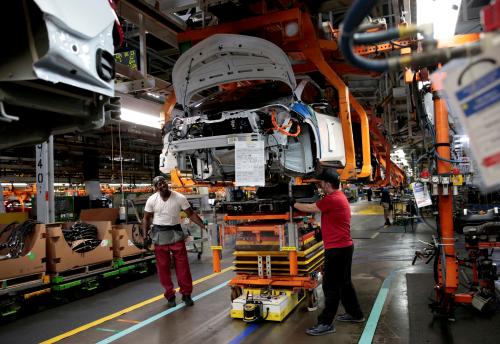It is remarkable, if often overlooked, that the U.S. trades as much with Canada and Mexico, the country’s first- and third-largest trading partners, as with Japan, Korea and the BRICS nations (Brazil, Russia, India, China, South Africa) combined. In part because of advantages afforded by NAFTA, enacted 20 years ago this month, firms have unleashed a torrent of trade in North America.
Yet North America is not merely the sum of our three national economies; rather it is driven by a network of city and metropolitan economies that produce and trade together based on their distinctive clusters of firms and industries.
At the forefront of this powerful network is Houston, which traded more than $35 billion in goods with Canada and Mexico, the highest total among all U.S. metropolitan areas in 2010, according to a recent Brookings Institution report.
What makes Houston such a critical hub for North American trade?
Energy, perhaps unsurprisingly, is the primary reason. Energy products account for half of Houston’s trade with Canada and Mexico.
The region remains the undisputed energy capital of North America, both taking in petroleum from Canadian cities like Calgary and Edmonton, its first and fourth largest metro trading partners in Canada, and refining it for the continent’s major population centers. Further, Houston’s global energy position may be bolstered by Mexico’s new energy reform, which is expected to expand its production south of the border.
Manufacturing also looms large in Houston’s trading profile. Goods such as chemicals and plastics, machinery and electronics account for another $14 billion of Houston’s North American goods trade.
These value chains implicate a slightly different set of North American metro trading partners for Houston – Toronto and Montreal for chemicals, Mexico City and Monterrey for machinery and Guadalajara and Tijuana for electronics.
A fully integrated manufacturing sector has united North America as one production platform. Indeed, at least a quarter of what we import from Mexico and Canada is actually American-made content; for China and Europe, that number is under 5 percent.
Houston’s firms are not only trading finished goods across borders, but making products together with firms in Canada and Mexico.
Houston will benefit from more recent dynamics – from rising labor costs abroad to new energy sources and technologies at home to favorable demographic trends – that present new comparative advantages for North America.
For all these reasons, Houston must act now to maintain and expand its role in North American trade.
We recommend three sets of actions.
First, set a vision. Houston’s leaders – across government, industry and civil society – ought to set a vision for their economy and develop market-driven approaches that take into account their place’s distinctive advantages.
Second, invest in what matters. Houston must maintain and expand the assets that drive trade – skilled workers, innovative institutions and universities and globally connected infrastructure.
Third, engage continentally to compete globally. Houston’s leaders should network with their peers in North America to strengthen trade relationships for mutual benefit.
The famous urbanist Jane Jacobs wrote 50 years ago that “the economic foundation of cities is trade.” Within North America, Houston’s prominent role reveals the reverse holds true, as well. The international exchange of people, goods, services, capital and ideas now rests squarely on a foundational network of trading cities.
This article originally appeared in the
Houston Chronicle
.



Commentary
Op-edNAFTA Helps Poise Houston to Grow Trade
January 2, 2014